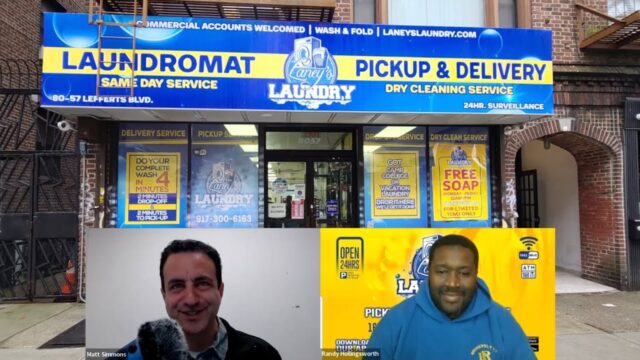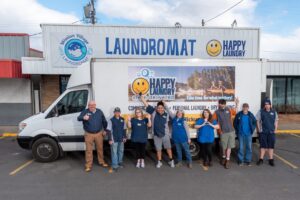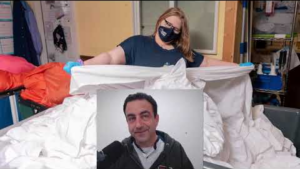Learn how Randy from Laney’s Laundry over TRIPLED his laundry pickup and delivery business in just one year, why he started a night shift, his plans for expansion, why he chose Curbside Laundries POS, how he grows his business because of competition, and how he transforms customers with complaints into loyal clients.
[TRANSCRIPT]
Speaker 1: 0:00
In this week’s episode of State of the Laundry Industry, we feature Randy Hollingsworth of Laney’s Laundry. He had been doing pickup and delivery for years, and within one year of getting the curbside laundries washing fold and pickup and delivery solution, he over tripled his pickup and delivery business,
Speaker 2: 0:18
Their system. It , it , it’s almost like hands off every , everything you want is, is there. I would have no clue where I’m going, where I’m headed , uh, without the software, especially for the , uh, the pickup and delivery.
Speaker 1: 0:32
I’m really excited to introduce Randy Hollingsworth. He’s with Laney’s Laundry over in Long Island and the guy’s just absolutely crushing it. So I’m just so excited to hear his story about how he got into Washington fold and pickup and delivery or just the laundry business for that matter. And his numbers are just incredible. I wouldn’t be surprised in just a few years that he’s gonna be grossing over a million dollars in Washington fold per year at his current trajectory. He’s just growing really, really fast. The other thing is his pickup and delivery is going off the hook too. He started up with curbside laundries just a couple years ago and already his pickup and delivery has tripled and in some cases quadrupled from year over year. So it’s just fascinating to watch him grow. He’s doing a lot of things right. I wanna find out what he’s doing, and he is in an area where there’s a lot of competition. So to see him rising to the top is just really exciting. And just wanted to introduce Randy and just curious as far as how you got started in , in Washington and , and in the laundry business.
Speaker 2: 1:31
Ooh , that’s a good question. Let’s see. Well, I got started seven years ago. I wanted a business that was more or less hands off . Well , I thought it was gonna be a hands off , you know, I’m not physically doing the, the laundry, but I just wanted something that, you know, I could go away on vacation and not have to worry about being there. So with that, I picked, you know, laundromat, why not?
Speaker 1: 2:01
That’s kind of the common joke in the laundry business is everybody got into it because it’s hands off . But then it turns out that there’s a little bit of work involved.
Speaker 2: 2:10
Yes, there is phone calls dealing with staff and soap and product and drivers, but it’s pretty easy, especially with the software.
Speaker 1: 2:21
So in washing fold , you know, it does add some more moving parts. So you got was and fold , which means you have to have staff and then you got pickup and delivery means you gotta have the vehicle. So just wondering like why you added that to, to the mix.
Speaker 2: 2:35
Well , we added pickup and delivery in the beginning is was because people were asking, oh, do you pick up? And I’m like, yes, <laugh> , you know, but we didn’t. But I’m like, yeah, what’s, yeah, what’s your address? We, we’ll , you know, we’ll we’ll pick it up. And we started doing that and was getting up to one, maybe even two pickups every day or every other day. But now we’re averaging about at least 20 a day. Some days we have 40 stops.
Speaker 1: 3:04
Tomorrow you’ve got like 36 stops , um, of pickup and deliveries . So it’s gone off the hook. Yeah. And how long were you doing pickup and delivery before you got curbside laundries ?
Speaker 2: 3:13
Uh , a few years. But it wasn’t anything , uh, you know, heavy. We’d get a call. It wasn’t , it wasn’t , uh, reoccurring customers. It was just, you know, more, more of a one-off. I see . I hurt my leg and you pick up my laundry.
Speaker 1: 3:25
Yes. So fascinating because now you have close to a hundred reoccurring customers, it’s like guaranteed money every week or every two weeks, they’re placing an order. Other part is you were doing pickup and delivering your numbers are good because you’ve been at it for a while . But then after you did , went with curbside laies one year later on average numbers tripled from what you’ve done
Speaker 2: 3:44
Before. Yeah, it took off. And I always feel like I’m not doing enough. I’m always striving to do more. Always pushing for, all right , how can we get more customers?
Speaker 1: 3:54
It’s always a good question to be asking it. That’s what I like about the software is that handles the day-to-day. It kind of puts out fires or prevents fires in the first place. It’s just a well-oiled machine. It goes into the system, there’s a system in place and then you can focus your time more on how do I get more customers? And that was interesting how you mentioned there’s an issue on quality control for a short period of time.
Speaker 2: 4:14
Yeah, I had some staffing issues. Had my top lady leave. She was putting in some uh , some pretty heavy hours, like 60 hours. So it’s almost like I had to replace two people and then they weren’t as fast as she was, wasn’t as neat as she was then you just kept hiring and kept hiring. And we finally are at a point now where I’m like, okay, we’re back to being close to where we were when she left. At that point I’m like, it’s time to do the , uh, text message blast. Like, hey, I know we haven’t been the , uh, the best lately, but we’ve gotten our act together. We’ve got new staffing, new procedures. Give us another shot. Here’s 15 bucks off. They got their prep together, you know, let me give them a shot. They’re reaching out to me, I’ll reach out to them.
Speaker 1: 5:03
The customers came back and then a lot of people who may not have placed an order for a while came back too. And something I thought you did was really smart too. We had a good reason to get them back in the mix. They might have been turned off and didn’t tell you they might just go somewhere else. And you were pretty generous with , with the coupon because you understood this is a retention business. Correct. And it’s all about the annual value of the customer, not the next order. And you’re like, you know what? I wanna get these guys back into the mix. And it was hugely successful. And I think that also because we’ve had the same stuff. We went through some dry cleaners, they were doing a good job until they weren’t probably because the staffing issues. And we had to tell our clients who were doing dry cleaning, Hey, we got a new dry cleaning partner and we were able to earn their business again. Same thing happened with our drivers. We , we , we were short on drivers and things kind of turned into a mess for about four to six weeks until we found the right team again. We let people know. So I think think one of the main lessons here is communication. We all go through our ups and downs and we hit our groove. And if you get outta groove, that’s okay, but get back on groove and let your clients know. Give us another try and we’re , we’re back to where we were.
Speaker 2: 6:09
Yeah, it’s very important. Don’t let it go too long. Don’t go six months and go, oh, let me reach out. They’re like, who are you? <laugh>? You gotta get ’em while it’s fresh.
Speaker 1: 6:20
Yeah, it’s another part, the software, it’s kinda like a nervous system where you could see what’s going on. You could just look on your dashboard on your phone or at home or wherever and you could say, wait, what’s going on? Why is the driver taking this much time? Or you could, you see instantly what your schedule for the week looks like. So it’s just right there at your fingertips
Speaker 2: 6:39
Right there.
Speaker 1: 6:41
There’s a lot of different pickup and delivery solutions out there. I was just curious as far as why you chose curbside laundries.
Speaker 2: 6:46
Well , I looked at all the others and uh, I dunno , this one just seemed to offer more. And uh , you know, when I called and I spoke to a curbside team, they were able to answer my questions and uh , not have to get back to me. Whereas others were like, oh, you know, we’re , we’re working on that. Oh, that’s something that we’re gonna be rolling out in the future. I know you guys are always rolling out, which is good, but these other people, they just had too much to roll
Speaker 1: 7:12
Out. Software takes time to roll stuff out. I’ve seen people strung along for six months or year. That feature was quote , being rolled out just never happened. They got strung along for six months or a year and then they’re like, you know what, I can’t wait any longer. So , exactly. We’ve got a software update coming out next month. We already started beta testing, so we’re just constantly making improvements. What your long-term strategy as far as where you see this going on pickup and delivery?
Speaker 2: 7:39
Glad you asked . <laugh> long-term strategy I see is getting another delivery van so that we can increase the areas we’re able to pick up from and deliver to. And as far as getting another store to handle it, we don’t need that. We can just increase the hours at our current, you know, location, which next week we’re starting 11:00 PM to 7:00 AM shift for the , for the first time.
Speaker 1: 8:07
Oh, that’s fantastic.
Speaker 2: 8:08
Yeah, I got a one employee for that shift. She’s gonna do uh , five days,
Speaker 1: 8:13
You know, the nighttime shift. It’s a little bit harder to find the right people for it. Some people say, oh yeah, I’ll do that . And then they do it one time and they’re like, you working in the night shift is not for me.
Speaker 2: 8:21
Exactly.
Speaker 1: 8:22
But , but the people it does work for, they love it because they don’t have somebody over their shoulder. They don’t have customers putting their load of laundry into the same machine that they were using. Cuz sometimes the attendance get kind of territorial, like these , this area’s mine, and then it’s just, they could do their thing without interruption. They’re just so much more efficient.
Speaker 2: 8:39
And you get so many people who want that 11:00 PM to 7:00 AM shift . I’ve gotten a a ton of people and none of them can do washing fold . I’m like, you told me you had experience. What , what is this <laugh> ? We test everyone out a couple hours. We put ’em on day. Like I’ve had this young lady on days for about two or three weeks. She’s gotten it now. So now we’re gonna shift her to the night shift, which she was hired
Speaker 1: 9:03
For. The software makes it so much easier because you could track the pounds at your fingertips. You could also see the initial weight and the final weight. So if there’s a discrepancy, like, hey, maybe there’s some mixed up stuff going on. So it does definitely help you keep tabs when you bring on new talents. Yeah.
Speaker 2: 9:21
Hard to find good. Hard to find good people.
Speaker 1: 9:24
It definitely is. We’ve got our core group and we keep adding to it. When you find the right people, you wanna keep ’em <laugh>. Yeah. I’m showing a map of, of New York and Long Island and just New Jersey. Each pin is a client of curbside, laundries gonna pick up and delivery. And you can’t even see New York. It is just covered in pins and there’s just so many people doing pickup and delivery. And then I see your numbers and it’s just crazy because you’re num you’re just growing. There’s no, and inside I think they’re just going up and up. Some people hesitate because there’s quote competition. What , what’s your feeling as far as how that affects business? How that’s affecting you?
Speaker 2: 10:01
Well, there’s a ton of competition in our area. In fact, there is a laundromat, I would say 50 feet from me . You can park in front , in front of my laundromat and either go into me or walk two doors down and go into the other guy. And the other guy is pick up and delivery only customers can’t walk in and do their own laundry. He has a lot of corporate accounts and things like that. He’s actually looking to go out in a few years. So I , you know, I told him , Hey listen, I’m, I’m here to take all your clients when you’re, when you’re ready. Lot of competition around the corner, there’s laundromats all
Speaker 1: 10:38
Over. I thought Long Beach was bad because there’s 80 some laundromats just in Long Beach and we’ve got so many that are within a half mile but not 50 feet. Because when I was in commercial real estate, the broker said if there’s a pizza place on each three corners of the block, so they got four corners and there’s a pizza place on three of the four corners, what should you , what should you build on the fourth corner? Pizza <laugh> ? The answer is pizza. Because that neighborhood loves pizza. <laugh>
Speaker 2: 11:06
<laugh> ,
Speaker 1: 11:09
Yeah . Yeah. Really comes down to your reputation of, because people are gonna look at your Yelp reviews and your Google reviews and are you guys doing a good job?
Speaker 2: 11:17
Yeah, that’s true. That’s true. They’re gonna look at all that Yelp, Google, word of mouth.
Speaker 1: 11:23
And ultimately it comes down to doing a good job. And that was awesome to see that you’re responsive. Like you hit a rough patch and then it’s like, okay, I got that fixed, but now I have to let the customers know I got that fixed. You know , getting it fixed isn’t good enough. You gotta communicate or taking care of the customer.
Speaker 2: 11:39
Yep . And that’s, that’s my main focus is , you know, take care of the customer. You , you’d be surprised what $10 off will do to a customer’s mindset. Oh, I wasn’t happy with this. They gave me $10 off my next order. I’m gonna continue to use them every week. That goes a long way.
Speaker 1: 11:54
That’s a great point. And also if a customer has a problem, store credit when possible is always the best route of going versus just, here’s a refund. Yeah. Store credit, one, they feel compensated. Two, it also implies they’re coming back so you have another chance to earn their business. Exactly. Thank you for being on the podcast. I think people will learn a lot as far as your journey and like the most important parts, keeping in touch with the customers and just doing a good job and wish you a continued success. And I think that’s fantastic. Just seeing your progress.
Speaker 2: 12:23
Yeah. Thank you so much. I love growing with , uh, curbside. You guys are helping me. So, you know, with your help I’m able to to keep it moving.
Speaker 1: 12:31
Yeah. And that’s one of the fun parts about building the software is we’re, we’re like, okay, which features are gonna help our clients make more money? And so those features go to the highest priority because we’ve got a laundromat too and just want stuff done so quickly. But, you know, things do take time, but we’re pedaled to the battle as far as development because the sooner certain features are out, the more money everybody’s gonna make. So we’re all in it together. So. Awesome. Just appreciate you for being a client and , uh, we’ll continue doing what we’re doing and hope , you know, keep making things better.
Speaker 2: 13:00
Thank you so very much.
Speaker 1: 13:02
If you’d like to learn more about the curbside laundries Washington fold and pick up and delivery solution, the same solution that helped Brandy triple his pick up and delivery business and just one year, go to curbside laundries.com. Don’t forget to click, like and subscribe. See you next time.


